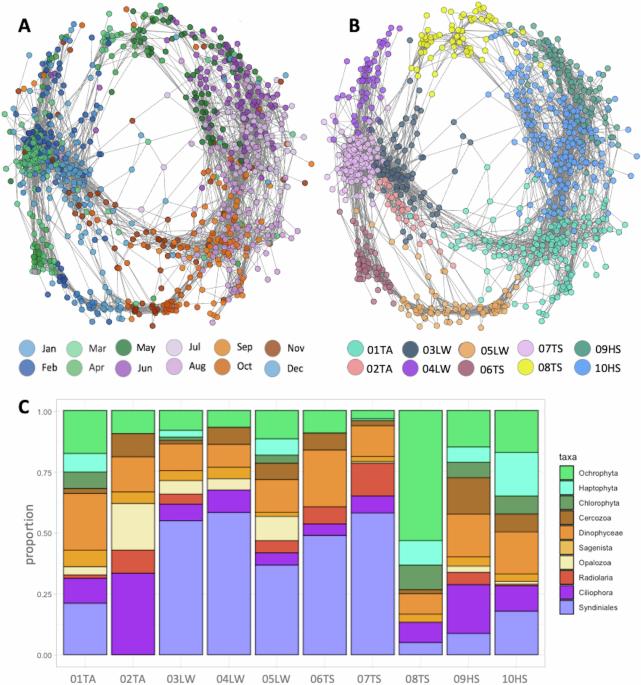Beyond blooms: the winter ecosystem reset determines microeukaryotic community dynamics in the Fram Strait
IF 8.1
1区 地球科学
Q1 ENVIRONMENTAL SCIENCES
引用次数: 0
Abstract
The Arctic Ocean is undergoing a major transition as a result of global warming, with uncertain consequences for its ecosystems. Our study introduces an integrated analytical approach using co-occurrence networks, convergent cross-mapping, and energy landscape analysis. Applied to four years of amplicon data from Fram Strait, located at the boundary between Arctic and Atlantic waters, our method identifies keystone species in seasonal microbial communities, elucidates causal interactions, and predicts stable configurations across changing environments. We find strong evidence for a “winter reset”, implying that organisms representing the spring bloom are largely determined by prevailing environmental conditions during winter. In addition, our analysis suggests that winter communities may adapt more readily to expected Atlantification than summer communities. These results highlight the utility of innovative time-series analyses in disentangling ecosystem dynamics. This approach provides critical insights into Arctic ecological interactions, dynamics, and resilience and aids in understanding ecosystem responses to environmental change. Winter environmental conditions largely determine prevailing organisms of spring blooms in the Fram Strait, according to a combined framework of co-occurrence networks, convergent cross-mapping networks, and energy landscape analysis.

藻华之外:冬季生态系统重置决定弗拉姆海峡微真核细胞群落动态
由于全球变暖,北冰洋正在经历重大转变,对其生态系统造成了不确定的后果。我们的研究采用共现网络、会聚交叉映射和能量景观分析等综合分析方法。我们的方法应用于位于北极和大西洋水域交界处的弗拉姆海峡四年的扩增子数据,识别了季节性微生物群落中的关键物种,阐明了因果互动关系,并预测了在不断变化的环境中的稳定配置。我们发现了 "冬季重置 "的有力证据,这意味着代表春季开花的生物在很大程度上取决于冬季的主要环境条件。此外,我们的分析表明,冬季群落可能比夏季群落更容易适应预期的亚特兰蒂斯化。这些结果凸显了创新性时间序列分析在厘清生态系统动态方面的作用。这种方法提供了对北极生态相互作用、动态和恢复力的重要见解,有助于理解生态系统对环境变化的反应。根据共现网络、聚合交叉映射网络和能量景观分析的组合框架,冬季环境条件在很大程度上决定了弗拉姆海峡春季开花的主要生物。
本文章由计算机程序翻译,如有差异,请以英文原文为准。
求助全文
约1分钟内获得全文
求助全文
来源期刊

Communications Earth & Environment
Earth and Planetary Sciences-General Earth and Planetary Sciences
CiteScore
8.60
自引率
2.50%
发文量
269
审稿时长
26 weeks
期刊介绍:
Communications Earth & Environment is an open access journal from Nature Portfolio publishing high-quality research, reviews and commentary in all areas of the Earth, environmental and planetary sciences. Research papers published by the journal represent significant advances that bring new insight to a specialized area in Earth science, planetary science or environmental science.
Communications Earth & Environment has a 2-year impact factor of 7.9 (2022 Journal Citation Reports®). Articles published in the journal in 2022 were downloaded 1,412,858 times. Median time from submission to the first editorial decision is 8 days.
 求助内容:
求助内容: 应助结果提醒方式:
应助结果提醒方式:


